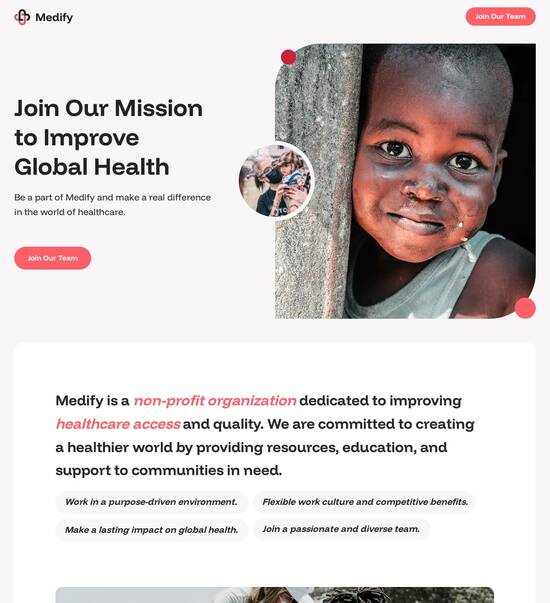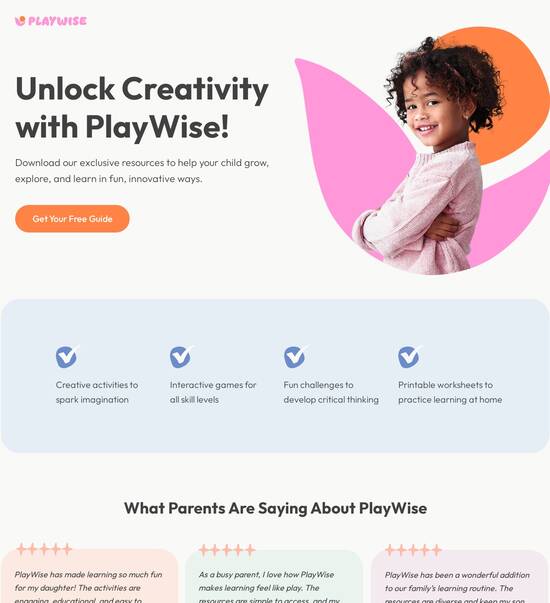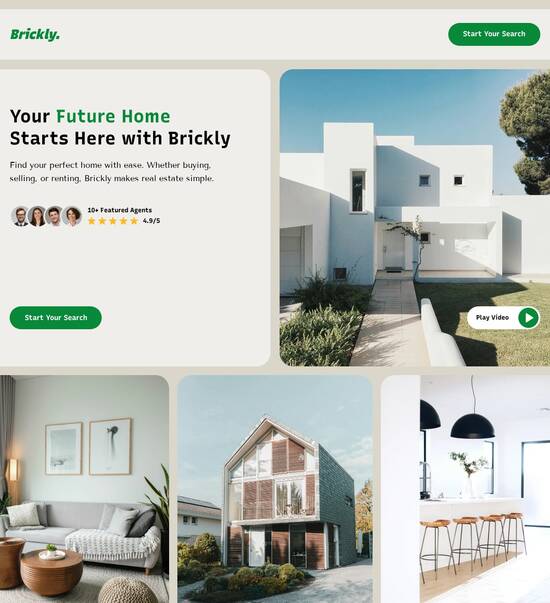
HTML page template for seafood restaurants
Use TemplateAbout template
Engage your audience like never before with stunning landing page templates for seafood restaurants. Make your online presence unforgettable!
Recommended templates

Easy to build without coding
With the intuitive drag-and-drop builder, anyone on your team can create high-converting pages without any knowledge of code or design. Make enhancements to your landing page with custom widgets using Javascript, HTML/CSS, or third-party scripts.

Multiple layouts for any industry and goal
Select from 500+ landing page layouts built to boost conversions across industry-specific scenarios. Customize them by adjusting fonts, adding images, and generating on-brand content with the AI assistant. Quickly scale with Instablocks® and Global Blocks that you can save, reuse, and update globally.

Loads fast and looks polished on any device
Every template is responsive, which means they present professionally on any device and load blazingly fast with our Thor Render Engine. You can also power them up with Google AMP technology to deliver an unparalleled mobile experience and drive higher conversions.

Robust analytics & experimentation
Get real-time updates and reporting across all your devices, showing the number of visitors, conversions, cost-per-visitor, and cost-per-lead. Launch AI-powered experiments, run A/B tests, and use heatmaps to analyze user behavior, then optimize your landing page to maximize conversions.







Easy to build without coding
With the intuitive drag-and-drop builder, anyone on your team can create high-converting pages without any knowledge of code or design. Make enhancements to your landing page with custom widgets using Javascript, HTML/CSS, or third-party scripts.
Multiple layouts for any industry and goal
Select from 500+ landing page layouts built to boost conversions across industry-specific scenarios. Customize them by adjusting fonts, adding images, and generating on-brand content with the AI assistant. Quickly scale with Instablocks® and Global Blocks that you can save, reuse, and update globally.
Loads fast and looks polished on any device
Every template is responsive, which means they present professionally on any device and load blazingly fast with our Thor Render Engine.
Robust analytics & experimentation
Get real-time updates and reporting across all your devices, showing the number of visitors, conversions, cost-per-visitor, and cost-per-lead. Launch AI-powered experiments, run A/B tests, and use heatmaps to analyze user behavior, then optimize your landing page to maximize conversions.
All the features you need to build lead-generating landing pages
Explore more featuresLearn how to build top-performing landing pages for any goal
FAQs
Leading the way in building high-performing landing pages





Create High-Impact Landing Pages with Instapage
Developing effective landing pages is vital for maximizing your digital marketing ROI. By leveraging Instapage's robust platform, marketers can create conversion-focused pages tailored for sectors like business services, tech, and education, ensuring that each audience receives a personalized experience.
Access Ready-to-Use Templates
Instapage offers over 100 high-converting landing page templates designed to suit various industries. These templates drastically reduce the time to go to market and help businesses capture leads effectively. No coding skills are required, allowing users of all levels to design aesthetically pleasing pages effortlessly.
- Diverse selection: Choose from templates that cater specifically to business services and marketing.
- Customization options: Tailor each template to align with your brand identity and audience needs.
- Lead generation elements: Integrate forms, buttons, and other components to enhance lead capture.
Optimize Landing Pages for Higher Conversions
Instapage's built-in experimentation features are essential for optimizing landing page performance. By utilizing A/B testing, marketers can identify which variations resonate most with their specific audience, thus maximizing the effectiveness of each campaign.
- Utilize heatmaps: Understand user behavior on your landing page to make informed design choices.
- Engage in A/B testing: Experiment with different headlines, images, and CTAs to determine what works best.
- Analytics dashboard: Monitor page performance in real time to fine-tune marketing strategies.
Create Personalized Experiences
Delivering personalized content is crucial for engaging your audience. Instapage allows marketers to use dynamic text replacement and tailored ad integration to ensure messages resonate with each viewer.
- Dynamic text replacement: Change text elements dynamically based on user data and behavior.
- AdMaps: Seamlessly align specific ads with designated landing pages for targeted messaging.
- Audience-level metrics: Track how well your landing pages convert for different segments.
In conclusion, using Instapage not only simplifies landing page creation but also enhances the overall marketing strategy. By employing its powerful features, marketing teams in the USA can enjoy improved workflow and higher conversion rates.
Start optimizing your landing pages and boost your campaign performance with Instapage today, and see the results for yourself!
HTML page template for seafood restaurants
The art of designing a seafood restaurant HTML page template
Designing an effective HTML page template for seafood restaurants goes beyond mere aesthetics; it plays a crucial role in creating a memorable dining experience. The initial visual impact on visitors directly influences customer perceptions and can determine whether they choose to dine with you. Therefore, every aspect of the design should invite patrons to explore your menu and enjoy your offerings.
Setting the mood: Visual elements like images and layouts can invoke feelings of comfort and excitement, making customers more likely to visit.
Connection to the ocean: Using colors such as blue and green can enhance the theme of freshness and oceanic allure inherent to seafood dining.
HTML templates not only provide beautiful designs but also streamline the web design process for seafood restaurants. By using pre-built elements, restaurant owners can significantly reduce the time spent on development and maintenance, allowing them to focus on their culinary offerings.
Core features of an effective seafood restaurant HTML page template
An effective seafood restaurant HTML template should include several core features to ensure a smooth user experience. The first consideration should be an attractive and easy-to-navigate structure. Visitors should be able to locate key menu items quickly, and the template should support mobile-responsive designs, allowing for seamless access across devices.
Mobile-responsive design: Vital for reaching customers across all digital platforms.
High-quality visual elements: Stunning images of seafood dishes will entice visitors.
Comprehensive menu display: Clear and interactive menus will help customers make informed dining choices.
Reservation and contact sections: Easy access to reservation systems and contact information enhances customer engagement.
High-quality images and content are essential components, as they create an immersive dining experience online. Integrating galleries and sliders can provide viewers with a glimpse of the ambiance and offerings, further enticing them to visit.
Technical advantages of the seafood restaurant HTML template
Digging deeper into the technical aspects, SEO optimization is fundamental for increasing the online visibility of seafood restaurants. Using appropriate tags and metadata not only boosts discoverability but also enhances search rankings in competitive food markets. Fast loading speeds are equally important; templates should implement minified scripts and optimized images to keep users engaged.
SEO optimization features: These include appropriate meta tags, descriptions, and keyword integration.
Fast loading speeds: Minimized scripts and image optimization to retain visitors on page.
In addition, compliance with accessibility standards ensures the website is usable for all visitors, including those with disabilities. Features like alt text for images and keyboard navigation can make a significant difference in user experience and satisfaction.
Leveraging JavaScript for enhanced interactivity
Incorporating JavaScript functionality brings an added layer of usability to seafood restaurant HTML templates. By utilizing event-driven programming techniques like `document.addEventListener`, restaurants can offer dynamic interaction capabilities where users can engage with elements like reservations and special offers. These interactive elements keep customers informed and engaged, ultimately leading to higher conversion rates.
User-generated events: Allowing customers to reserve tables or inquire about special offers.
Improved UI experience: Implementing behaviors that enhance how users interact with the page.
Moreover, ensuring that content loads efficiently is paramount. Using the `DOMContentLoaded` event helps prioritize critical elements, which can significantly minimize wait times for visitors. Asynchronous loading techniques can also be employed for multimedia elements, helping keep the overall performance smooth and uninterrupted.
Design innovations for seafood restaurant templates
When it comes to design, uniqueness can set a seafood restaurant apart from competitors. Templates should explore various layout designs, whether opting for a one-page or multi-page format. The choice between the two can hinge on the volume of information presented and the desired user journey.
One-page layouts: Effective for simpler, more engaging presentations.
Multi-page layouts: Optimal for extensive menus and additional information.
Integrating thematic elements: Careful use of visuals can enhance the dining experience without overwhelming guests.
Color dynamics play a crucial role in mood building. Blues and greens are traditionally associated with the ocean, evoking feelings of freshness and tranquility. Using gradients can further enhance these emotions, creating a visually appealing atmosphere that resonates with the restaurant's theme.
Customizability and scalability of templates
A flexible seafood restaurant HTML template should offer the ability to customize features based on business needs. This might include seasonal menus, promotional events, or new dish introductions. Customizability ensures that the website remains relevant and engaging to repeat visitors.
Easy customization options for seasonal menus and promotions.
Scalability: The ability to add new locations or features as the business grows.
In addition, promoting eco-friendly and sustainable practices through web design can greatly enhance a restaurant's image. By showcasing sustainable sourcing and eco-friendly initiatives, businesses can engage customers who value ethical practices in their dining options.
Case studies: Successful seafood restaurant HTML template utilizations
Examining successful cases of seafood restaurants can provide valuable insights into which features captivate customers. Many local favorites have leveraged the right templates to enhance their online presence and increase reservations. Notably, incorporating interactive menus, strong visual elements, and easy navigation have proven critical for engagement.
Success stories: Case studies demonstrating elevated online engagement through template use.
Key features: Elements such as quick reservation systems and stunning visuals contribute to increased customer interest.
On a global scale, seafood restaurant designs can vary significantly based on cultural preferences. Learning from these differences can provide local businesses with innovative ideas to enhance their web presence.
The future of seafood restaurant web design
As the restaurant industry evolves, so too does the design landscape. Emerging trends such as AI integration and the use of chatbots for enhanced customer service are gaining traction. For seafood restaurants, these technologies could provide more tailored experiences, helping to manage customer interactions effectively.
Integration of AI and chatbots: Enhancing customer service and interaction.
Augmented reality for menu viewing: Offering customers immersive experiences.
Adapting to changing consumer needs is crucial for success. As food trends evolve, seafood restaurant websites must remain flexible to incorporate modern elements and maintain relevance in a competitive market. Future-proofing templates will help businesses adapt and thrive.
Ready to skyrocket conversions?
Supercharge your ad campaigns with high-performing landing pages
Get started














